Causes, Effects, and Solutions for African Desertification
VerifiedAdded on 2022/09/29
|16
|4478
|71
Report
AI Summary
This report addresses the critical issue of desertification in Africa, examining its multifaceted causes, including climate change, unsustainable land management practices, and population growth. It details the far-reaching impacts of desertification on the African economy, leading to poverty, reduced agricultural productivity, and food insecurity, as well as its effects on society, including forced migration and conflict. The report highlights the link between climate change, including global warming and fluctuating rainfall patterns, and the increased land degradation. It also explores the socio-economic consequences and environmental refugees. It then suggests possible solutions, such as raising public awareness, sustainable land management practices, and international cooperation to combat desertification and promote sustainable development. The report emphasizes the need for integrated strategies to mitigate the effects of desertification and secure a more sustainable future for Africa. The document is a contribution by a student to be published on Desklib, a platform providing AI-based study tools.

Student’s Last Name 1
Desertification Problem in Africa
By (Name)
Course
Professor
University
Date
Desertification Problem in Africa
By (Name)
Course
Professor
University
Date
Paraphrase This Document
Need a fresh take? Get an instant paraphrase of this document with our AI Paraphraser

Student’s Last Name 2
Introduction
There is a consensus that both at the global, regional, as well as the national political
agenda, the issues of Desertification, Land Degradation, and Drought (DLDD) are insufficiently
addressed. Hence, it is essential to raise awareness on these matters, not only basing the
arguments on DLDD’s negative effects in regards to the socio-economic but as well on the
opportunities that they are likely to create in guiding current land management practices to
ensure that they are more resilient and sustainable. Understanding the economic along with the
social costs as well as benefits associated with DLDD is important if the governments are to
develop cost-effective laws and strategies to address the issues, including raising awareness.
Specifically, desertification in Africa is a big problem that is affecting the economy, state, and
society. Desertification is considered among the main challenges that are hindering Africa’s
sustainable development. The issue has a far-reaching unfavorable effect on food security,
physical infrastructure, human health, natural resources and the environment, economic activity,
including national as well as national security.
Desertification refers to the permanent decline in dryland areas’ biological productivity.
It is estimated that 250 million individuals in over 100 countries globally are affected by
desertification. However, the issue is more prevalent in Africa, in which case, approximately
66% of the total land is either semi-arid or arid. In Africa, the causes of desertification are both
natural and man-made. Despite being sensitive to human activities, already dry lands result from
drought, climate change, increasing global temperatures, along with unpredictable rain patterns.
Some of the human-induced reasons that contribute to desertification include agricultural
technologies, population growth, and unsustainable policies. Due to these factors, the land is
degraded, creating effects that translate to the loss in biodiversity, including other outcomes that
Introduction
There is a consensus that both at the global, regional, as well as the national political
agenda, the issues of Desertification, Land Degradation, and Drought (DLDD) are insufficiently
addressed. Hence, it is essential to raise awareness on these matters, not only basing the
arguments on DLDD’s negative effects in regards to the socio-economic but as well on the
opportunities that they are likely to create in guiding current land management practices to
ensure that they are more resilient and sustainable. Understanding the economic along with the
social costs as well as benefits associated with DLDD is important if the governments are to
develop cost-effective laws and strategies to address the issues, including raising awareness.
Specifically, desertification in Africa is a big problem that is affecting the economy, state, and
society. Desertification is considered among the main challenges that are hindering Africa’s
sustainable development. The issue has a far-reaching unfavorable effect on food security,
physical infrastructure, human health, natural resources and the environment, economic activity,
including national as well as national security.
Desertification refers to the permanent decline in dryland areas’ biological productivity.
It is estimated that 250 million individuals in over 100 countries globally are affected by
desertification. However, the issue is more prevalent in Africa, in which case, approximately
66% of the total land is either semi-arid or arid. In Africa, the causes of desertification are both
natural and man-made. Despite being sensitive to human activities, already dry lands result from
drought, climate change, increasing global temperatures, along with unpredictable rain patterns.
Some of the human-induced reasons that contribute to desertification include agricultural
technologies, population growth, and unsustainable policies. Due to these factors, the land is
degraded, creating effects that translate to the loss in biodiversity, including other outcomes that
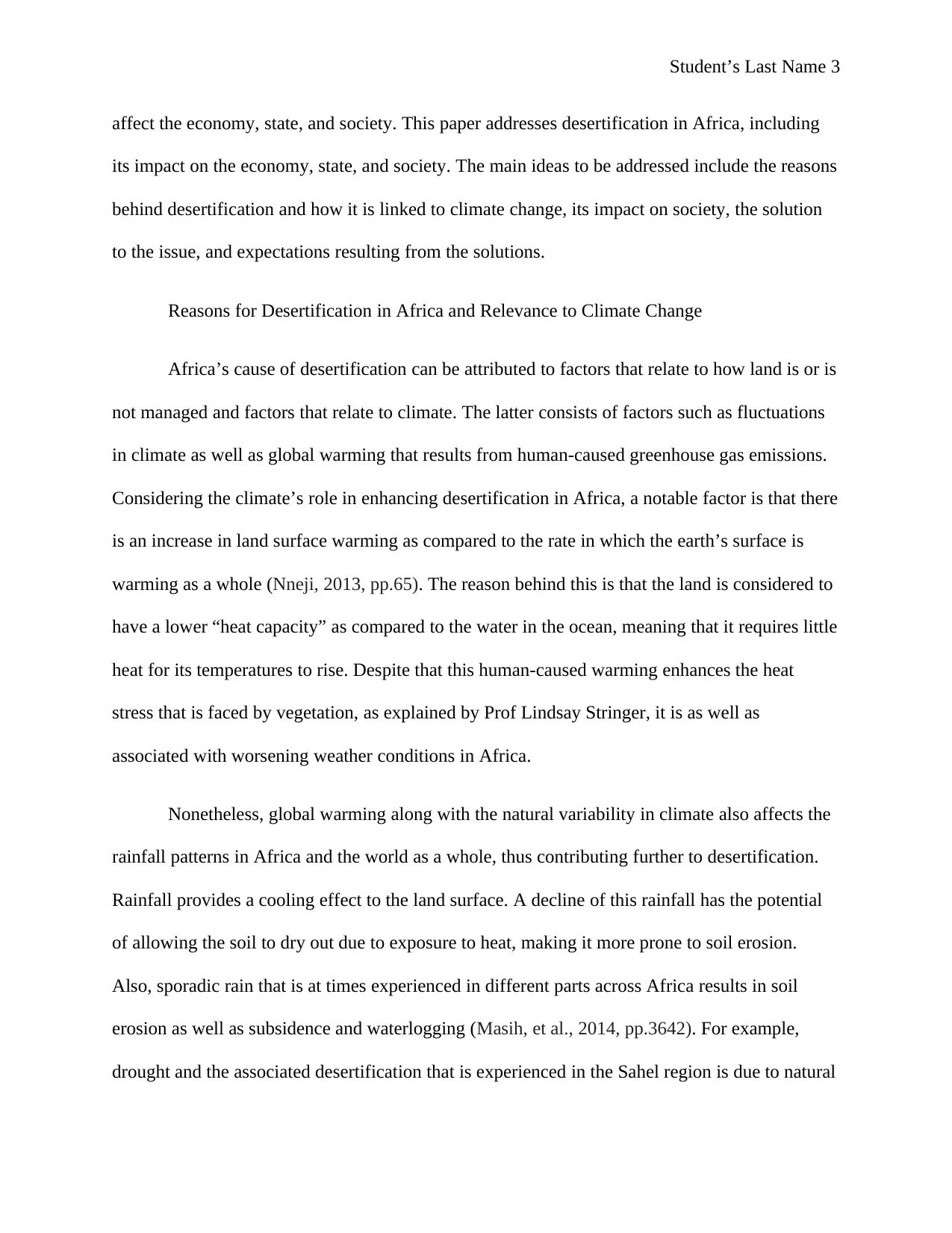
Student’s Last Name 3
affect the economy, state, and society. This paper addresses desertification in Africa, including
its impact on the economy, state, and society. The main ideas to be addressed include the reasons
behind desertification and how it is linked to climate change, its impact on society, the solution
to the issue, and expectations resulting from the solutions.
Reasons for Desertification in Africa and Relevance to Climate Change
Africa’s cause of desertification can be attributed to factors that relate to how land is or is
not managed and factors that relate to climate. The latter consists of factors such as fluctuations
in climate as well as global warming that results from human-caused greenhouse gas emissions.
Considering the climate’s role in enhancing desertification in Africa, a notable factor is that there
is an increase in land surface warming as compared to the rate in which the earth’s surface is
warming as a whole (Nneji, 2013, pp.65). The reason behind this is that the land is considered to
have a lower “heat capacity” as compared to the water in the ocean, meaning that it requires little
heat for its temperatures to rise. Despite that this human-caused warming enhances the heat
stress that is faced by vegetation, as explained by Prof Lindsay Stringer, it is as well as
associated with worsening weather conditions in Africa.
Nonetheless, global warming along with the natural variability in climate also affects the
rainfall patterns in Africa and the world as a whole, thus contributing further to desertification.
Rainfall provides a cooling effect to the land surface. A decline of this rainfall has the potential
of allowing the soil to dry out due to exposure to heat, making it more prone to soil erosion.
Also, sporadic rain that is at times experienced in different parts across Africa results in soil
erosion as well as subsidence and waterlogging (Masih, et al., 2014, pp.3642). For example,
drought and the associated desertification that is experienced in the Sahel region is due to natural
affect the economy, state, and society. This paper addresses desertification in Africa, including
its impact on the economy, state, and society. The main ideas to be addressed include the reasons
behind desertification and how it is linked to climate change, its impact on society, the solution
to the issue, and expectations resulting from the solutions.
Reasons for Desertification in Africa and Relevance to Climate Change
Africa’s cause of desertification can be attributed to factors that relate to how land is or is
not managed and factors that relate to climate. The latter consists of factors such as fluctuations
in climate as well as global warming that results from human-caused greenhouse gas emissions.
Considering the climate’s role in enhancing desertification in Africa, a notable factor is that there
is an increase in land surface warming as compared to the rate in which the earth’s surface is
warming as a whole (Nneji, 2013, pp.65). The reason behind this is that the land is considered to
have a lower “heat capacity” as compared to the water in the ocean, meaning that it requires little
heat for its temperatures to rise. Despite that this human-caused warming enhances the heat
stress that is faced by vegetation, as explained by Prof Lindsay Stringer, it is as well as
associated with worsening weather conditions in Africa.
Nonetheless, global warming along with the natural variability in climate also affects the
rainfall patterns in Africa and the world as a whole, thus contributing further to desertification.
Rainfall provides a cooling effect to the land surface. A decline of this rainfall has the potential
of allowing the soil to dry out due to exposure to heat, making it more prone to soil erosion.
Also, sporadic rain that is at times experienced in different parts across Africa results in soil
erosion as well as subsidence and waterlogging (Masih, et al., 2014, pp.3642). For example,
drought and the associated desertification that is experienced in the Sahel region is due to natural
⊘ This is a preview!⊘
Do you want full access?
Subscribe today to unlock all pages.

Trusted by 1+ million students worldwide
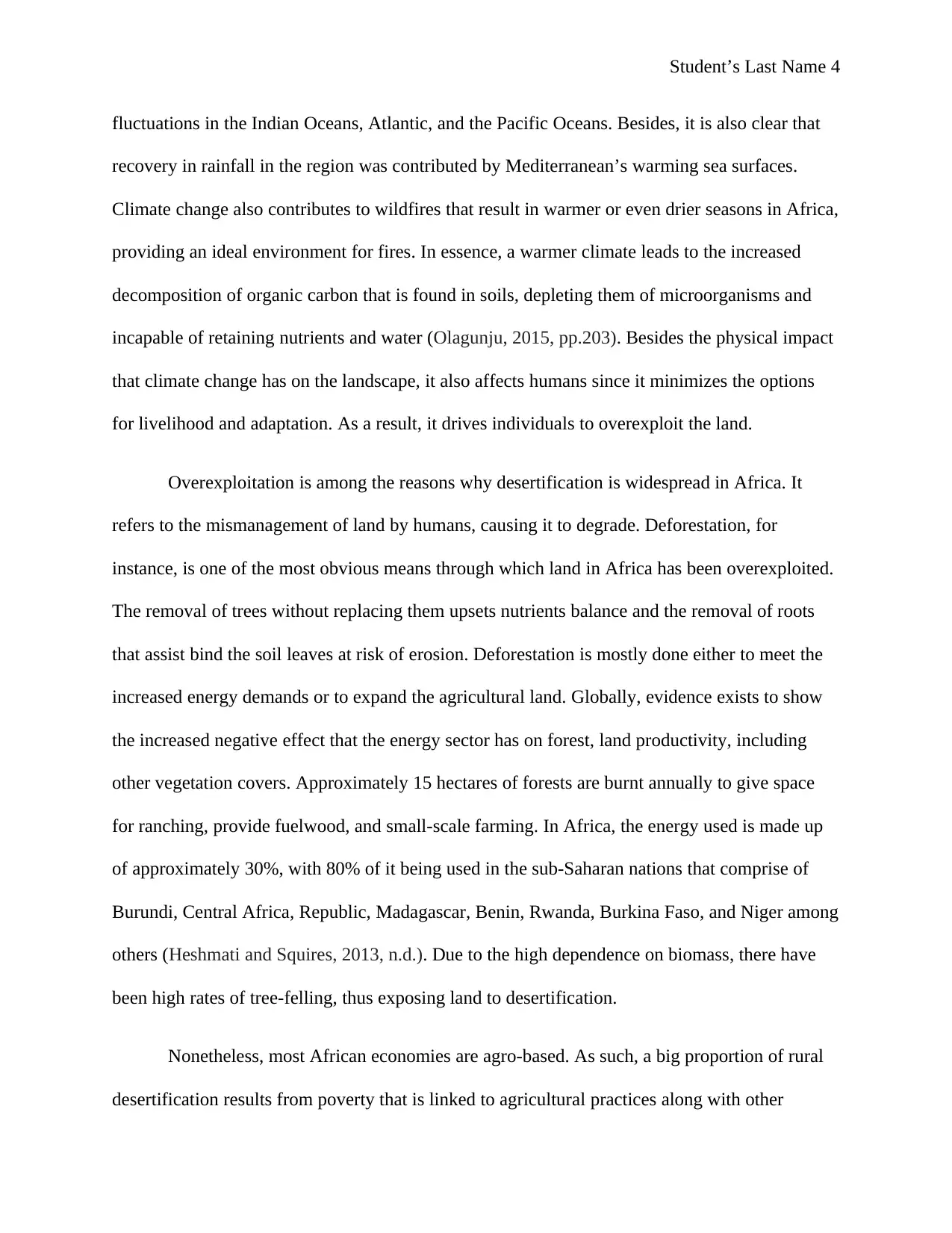
Student’s Last Name 4
fluctuations in the Indian Oceans, Atlantic, and the Pacific Oceans. Besides, it is also clear that
recovery in rainfall in the region was contributed by Mediterranean’s warming sea surfaces.
Climate change also contributes to wildfires that result in warmer or even drier seasons in Africa,
providing an ideal environment for fires. In essence, a warmer climate leads to the increased
decomposition of organic carbon that is found in soils, depleting them of microorganisms and
incapable of retaining nutrients and water (Olagunju, 2015, pp.203). Besides the physical impact
that climate change has on the landscape, it also affects humans since it minimizes the options
for livelihood and adaptation. As a result, it drives individuals to overexploit the land.
Overexploitation is among the reasons why desertification is widespread in Africa. It
refers to the mismanagement of land by humans, causing it to degrade. Deforestation, for
instance, is one of the most obvious means through which land in Africa has been overexploited.
The removal of trees without replacing them upsets nutrients balance and the removal of roots
that assist bind the soil leaves at risk of erosion. Deforestation is mostly done either to meet the
increased energy demands or to expand the agricultural land. Globally, evidence exists to show
the increased negative effect that the energy sector has on forest, land productivity, including
other vegetation covers. Approximately 15 hectares of forests are burnt annually to give space
for ranching, provide fuelwood, and small-scale farming. In Africa, the energy used is made up
of approximately 30%, with 80% of it being used in the sub-Saharan nations that comprise of
Burundi, Central Africa, Republic, Madagascar, Benin, Rwanda, Burkina Faso, and Niger among
others (Heshmati and Squires, 2013, n.d.). Due to the high dependence on biomass, there have
been high rates of tree-felling, thus exposing land to desertification.
Nonetheless, most African economies are agro-based. As such, a big proportion of rural
desertification results from poverty that is linked to agricultural practices along with other
fluctuations in the Indian Oceans, Atlantic, and the Pacific Oceans. Besides, it is also clear that
recovery in rainfall in the region was contributed by Mediterranean’s warming sea surfaces.
Climate change also contributes to wildfires that result in warmer or even drier seasons in Africa,
providing an ideal environment for fires. In essence, a warmer climate leads to the increased
decomposition of organic carbon that is found in soils, depleting them of microorganisms and
incapable of retaining nutrients and water (Olagunju, 2015, pp.203). Besides the physical impact
that climate change has on the landscape, it also affects humans since it minimizes the options
for livelihood and adaptation. As a result, it drives individuals to overexploit the land.
Overexploitation is among the reasons why desertification is widespread in Africa. It
refers to the mismanagement of land by humans, causing it to degrade. Deforestation, for
instance, is one of the most obvious means through which land in Africa has been overexploited.
The removal of trees without replacing them upsets nutrients balance and the removal of roots
that assist bind the soil leaves at risk of erosion. Deforestation is mostly done either to meet the
increased energy demands or to expand the agricultural land. Globally, evidence exists to show
the increased negative effect that the energy sector has on forest, land productivity, including
other vegetation covers. Approximately 15 hectares of forests are burnt annually to give space
for ranching, provide fuelwood, and small-scale farming. In Africa, the energy used is made up
of approximately 30%, with 80% of it being used in the sub-Saharan nations that comprise of
Burundi, Central Africa, Republic, Madagascar, Benin, Rwanda, Burkina Faso, and Niger among
others (Heshmati and Squires, 2013, n.d.). Due to the high dependence on biomass, there have
been high rates of tree-felling, thus exposing land to desertification.
Nonetheless, most African economies are agro-based. As such, a big proportion of rural
desertification results from poverty that is linked to agricultural practices along with other
Paraphrase This Document
Need a fresh take? Get an instant paraphrase of this document with our AI Paraphraser
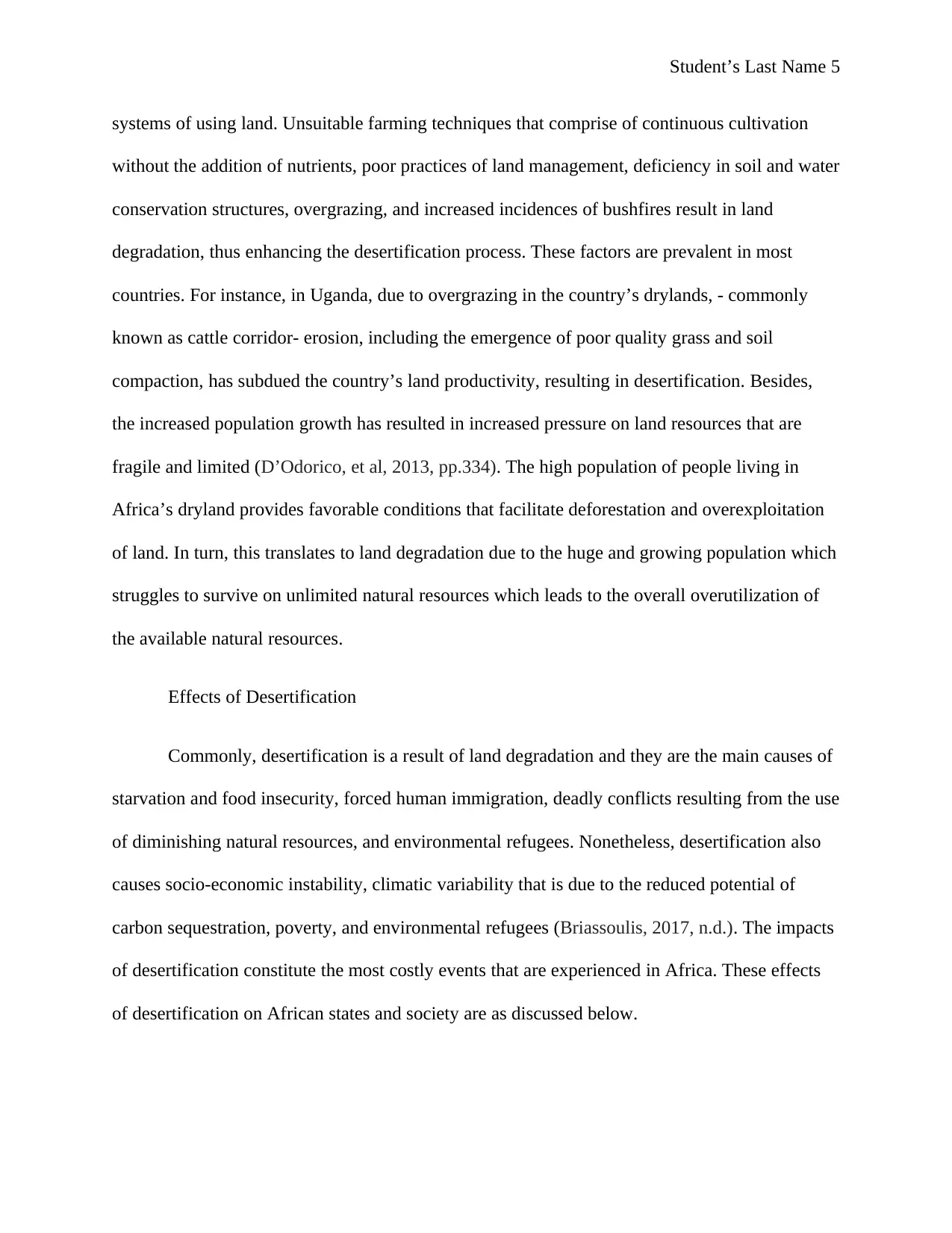
Student’s Last Name 5
systems of using land. Unsuitable farming techniques that comprise of continuous cultivation
without the addition of nutrients, poor practices of land management, deficiency in soil and water
conservation structures, overgrazing, and increased incidences of bushfires result in land
degradation, thus enhancing the desertification process. These factors are prevalent in most
countries. For instance, in Uganda, due to overgrazing in the country’s drylands, - commonly
known as cattle corridor- erosion, including the emergence of poor quality grass and soil
compaction, has subdued the country’s land productivity, resulting in desertification. Besides,
the increased population growth has resulted in increased pressure on land resources that are
fragile and limited (D’Odorico, et al, 2013, pp.334). The high population of people living in
Africa’s dryland provides favorable conditions that facilitate deforestation and overexploitation
of land. In turn, this translates to land degradation due to the huge and growing population which
struggles to survive on unlimited natural resources which leads to the overall overutilization of
the available natural resources.
Effects of Desertification
Commonly, desertification is a result of land degradation and they are the main causes of
starvation and food insecurity, forced human immigration, deadly conflicts resulting from the use
of diminishing natural resources, and environmental refugees. Nonetheless, desertification also
causes socio-economic instability, climatic variability that is due to the reduced potential of
carbon sequestration, poverty, and environmental refugees (Briassoulis, 2017, n.d.). The impacts
of desertification constitute the most costly events that are experienced in Africa. These effects
of desertification on African states and society are as discussed below.
systems of using land. Unsuitable farming techniques that comprise of continuous cultivation
without the addition of nutrients, poor practices of land management, deficiency in soil and water
conservation structures, overgrazing, and increased incidences of bushfires result in land
degradation, thus enhancing the desertification process. These factors are prevalent in most
countries. For instance, in Uganda, due to overgrazing in the country’s drylands, - commonly
known as cattle corridor- erosion, including the emergence of poor quality grass and soil
compaction, has subdued the country’s land productivity, resulting in desertification. Besides,
the increased population growth has resulted in increased pressure on land resources that are
fragile and limited (D’Odorico, et al, 2013, pp.334). The high population of people living in
Africa’s dryland provides favorable conditions that facilitate deforestation and overexploitation
of land. In turn, this translates to land degradation due to the huge and growing population which
struggles to survive on unlimited natural resources which leads to the overall overutilization of
the available natural resources.
Effects of Desertification
Commonly, desertification is a result of land degradation and they are the main causes of
starvation and food insecurity, forced human immigration, deadly conflicts resulting from the use
of diminishing natural resources, and environmental refugees. Nonetheless, desertification also
causes socio-economic instability, climatic variability that is due to the reduced potential of
carbon sequestration, poverty, and environmental refugees (Briassoulis, 2017, n.d.). The impacts
of desertification constitute the most costly events that are experienced in Africa. These effects
of desertification on African states and society are as discussed below.
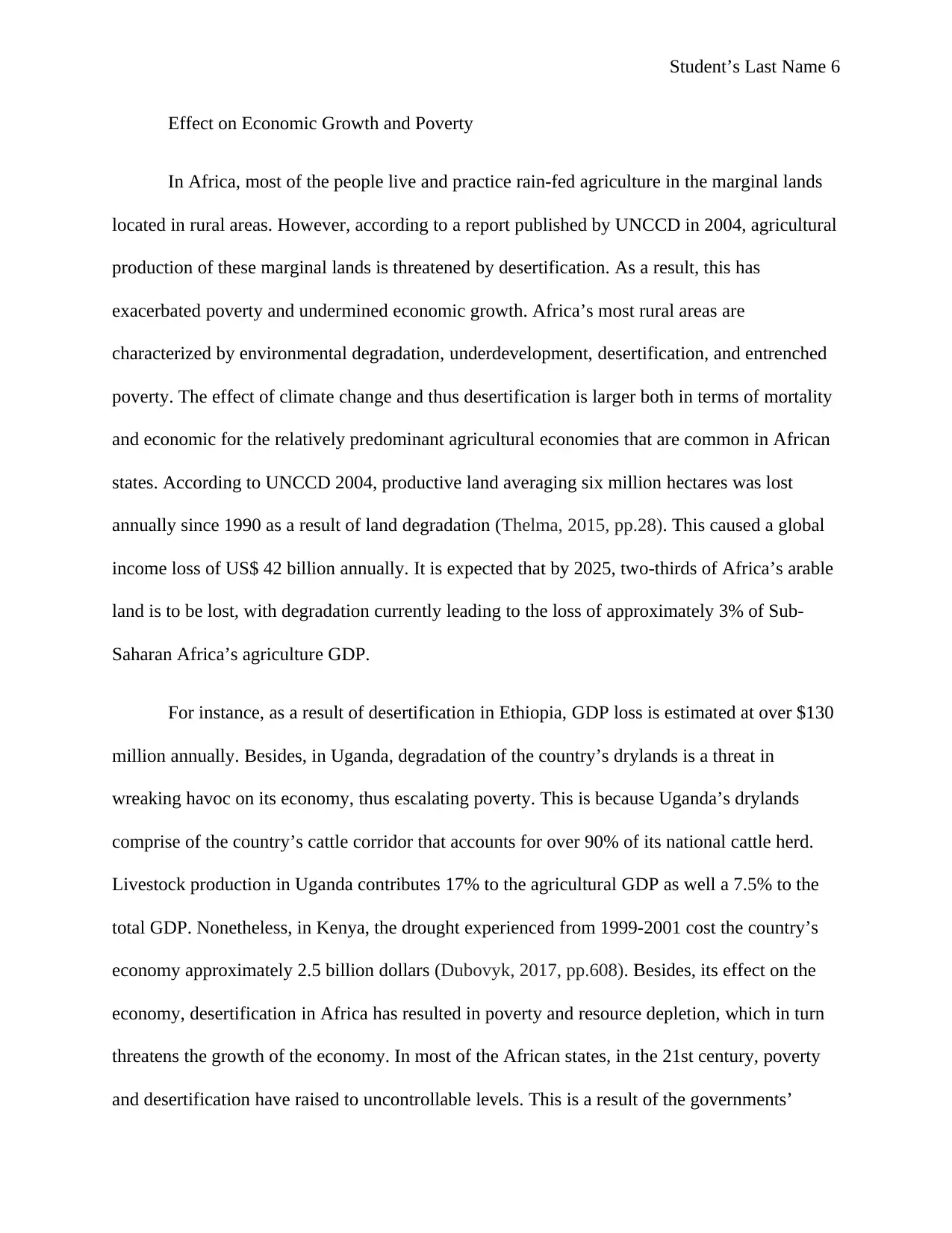
Student’s Last Name 6
Effect on Economic Growth and Poverty
In Africa, most of the people live and practice rain-fed agriculture in the marginal lands
located in rural areas. However, according to a report published by UNCCD in 2004, agricultural
production of these marginal lands is threatened by desertification. As a result, this has
exacerbated poverty and undermined economic growth. Africa’s most rural areas are
characterized by environmental degradation, underdevelopment, desertification, and entrenched
poverty. The effect of climate change and thus desertification is larger both in terms of mortality
and economic for the relatively predominant agricultural economies that are common in African
states. According to UNCCD 2004, productive land averaging six million hectares was lost
annually since 1990 as a result of land degradation (Thelma, 2015, pp.28). This caused a global
income loss of US$ 42 billion annually. It is expected that by 2025, two-thirds of Africa’s arable
land is to be lost, with degradation currently leading to the loss of approximately 3% of Sub-
Saharan Africa’s agriculture GDP.
For instance, as a result of desertification in Ethiopia, GDP loss is estimated at over $130
million annually. Besides, in Uganda, degradation of the country’s drylands is a threat in
wreaking havoc on its economy, thus escalating poverty. This is because Uganda’s drylands
comprise of the country’s cattle corridor that accounts for over 90% of its national cattle herd.
Livestock production in Uganda contributes 17% to the agricultural GDP as well a 7.5% to the
total GDP. Nonetheless, in Kenya, the drought experienced from 1999-2001 cost the country’s
economy approximately 2.5 billion dollars (Dubovyk, 2017, pp.608). Besides, its effect on the
economy, desertification in Africa has resulted in poverty and resource depletion, which in turn
threatens the growth of the economy. In most of the African states, in the 21st century, poverty
and desertification have raised to uncontrollable levels. This is a result of the governments’
Effect on Economic Growth and Poverty
In Africa, most of the people live and practice rain-fed agriculture in the marginal lands
located in rural areas. However, according to a report published by UNCCD in 2004, agricultural
production of these marginal lands is threatened by desertification. As a result, this has
exacerbated poverty and undermined economic growth. Africa’s most rural areas are
characterized by environmental degradation, underdevelopment, desertification, and entrenched
poverty. The effect of climate change and thus desertification is larger both in terms of mortality
and economic for the relatively predominant agricultural economies that are common in African
states. According to UNCCD 2004, productive land averaging six million hectares was lost
annually since 1990 as a result of land degradation (Thelma, 2015, pp.28). This caused a global
income loss of US$ 42 billion annually. It is expected that by 2025, two-thirds of Africa’s arable
land is to be lost, with degradation currently leading to the loss of approximately 3% of Sub-
Saharan Africa’s agriculture GDP.
For instance, as a result of desertification in Ethiopia, GDP loss is estimated at over $130
million annually. Besides, in Uganda, degradation of the country’s drylands is a threat in
wreaking havoc on its economy, thus escalating poverty. This is because Uganda’s drylands
comprise of the country’s cattle corridor that accounts for over 90% of its national cattle herd.
Livestock production in Uganda contributes 17% to the agricultural GDP as well a 7.5% to the
total GDP. Nonetheless, in Kenya, the drought experienced from 1999-2001 cost the country’s
economy approximately 2.5 billion dollars (Dubovyk, 2017, pp.608). Besides, its effect on the
economy, desertification in Africa has resulted in poverty and resource depletion, which in turn
threatens the growth of the economy. In most of the African states, in the 21st century, poverty
and desertification have raised to uncontrollable levels. This is a result of the governments’
⊘ This is a preview!⊘
Do you want full access?
Subscribe today to unlock all pages.

Trusted by 1+ million students worldwide
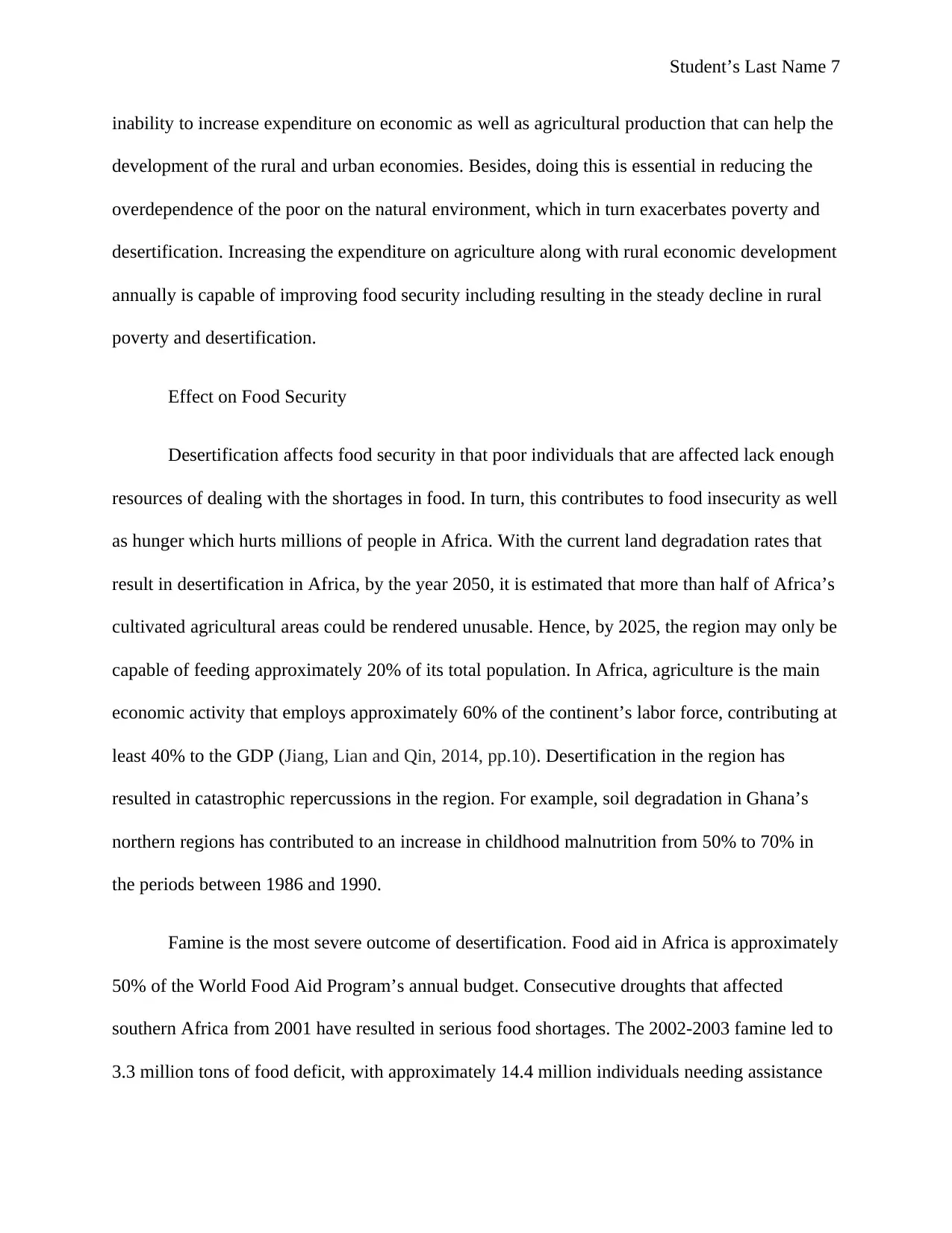
Student’s Last Name 7
inability to increase expenditure on economic as well as agricultural production that can help the
development of the rural and urban economies. Besides, doing this is essential in reducing the
overdependence of the poor on the natural environment, which in turn exacerbates poverty and
desertification. Increasing the expenditure on agriculture along with rural economic development
annually is capable of improving food security including resulting in the steady decline in rural
poverty and desertification.
Effect on Food Security
Desertification affects food security in that poor individuals that are affected lack enough
resources of dealing with the shortages in food. In turn, this contributes to food insecurity as well
as hunger which hurts millions of people in Africa. With the current land degradation rates that
result in desertification in Africa, by the year 2050, it is estimated that more than half of Africa’s
cultivated agricultural areas could be rendered unusable. Hence, by 2025, the region may only be
capable of feeding approximately 20% of its total population. In Africa, agriculture is the main
economic activity that employs approximately 60% of the continent’s labor force, contributing at
least 40% to the GDP (Jiang, Lian and Qin, 2014, pp.10). Desertification in the region has
resulted in catastrophic repercussions in the region. For example, soil degradation in Ghana’s
northern regions has contributed to an increase in childhood malnutrition from 50% to 70% in
the periods between 1986 and 1990.
Famine is the most severe outcome of desertification. Food aid in Africa is approximately
50% of the World Food Aid Program’s annual budget. Consecutive droughts that affected
southern Africa from 2001 have resulted in serious food shortages. The 2002-2003 famine led to
3.3 million tons of food deficit, with approximately 14.4 million individuals needing assistance
inability to increase expenditure on economic as well as agricultural production that can help the
development of the rural and urban economies. Besides, doing this is essential in reducing the
overdependence of the poor on the natural environment, which in turn exacerbates poverty and
desertification. Increasing the expenditure on agriculture along with rural economic development
annually is capable of improving food security including resulting in the steady decline in rural
poverty and desertification.
Effect on Food Security
Desertification affects food security in that poor individuals that are affected lack enough
resources of dealing with the shortages in food. In turn, this contributes to food insecurity as well
as hunger which hurts millions of people in Africa. With the current land degradation rates that
result in desertification in Africa, by the year 2050, it is estimated that more than half of Africa’s
cultivated agricultural areas could be rendered unusable. Hence, by 2025, the region may only be
capable of feeding approximately 20% of its total population. In Africa, agriculture is the main
economic activity that employs approximately 60% of the continent’s labor force, contributing at
least 40% to the GDP (Jiang, Lian and Qin, 2014, pp.10). Desertification in the region has
resulted in catastrophic repercussions in the region. For example, soil degradation in Ghana’s
northern regions has contributed to an increase in childhood malnutrition from 50% to 70% in
the periods between 1986 and 1990.
Famine is the most severe outcome of desertification. Food aid in Africa is approximately
50% of the World Food Aid Program’s annual budget. Consecutive droughts that affected
southern Africa from 2001 have resulted in serious food shortages. The 2002-2003 famine led to
3.3 million tons of food deficit, with approximately 14.4 million individuals needing assistance
Paraphrase This Document
Need a fresh take? Get an instant paraphrase of this document with our AI Paraphraser
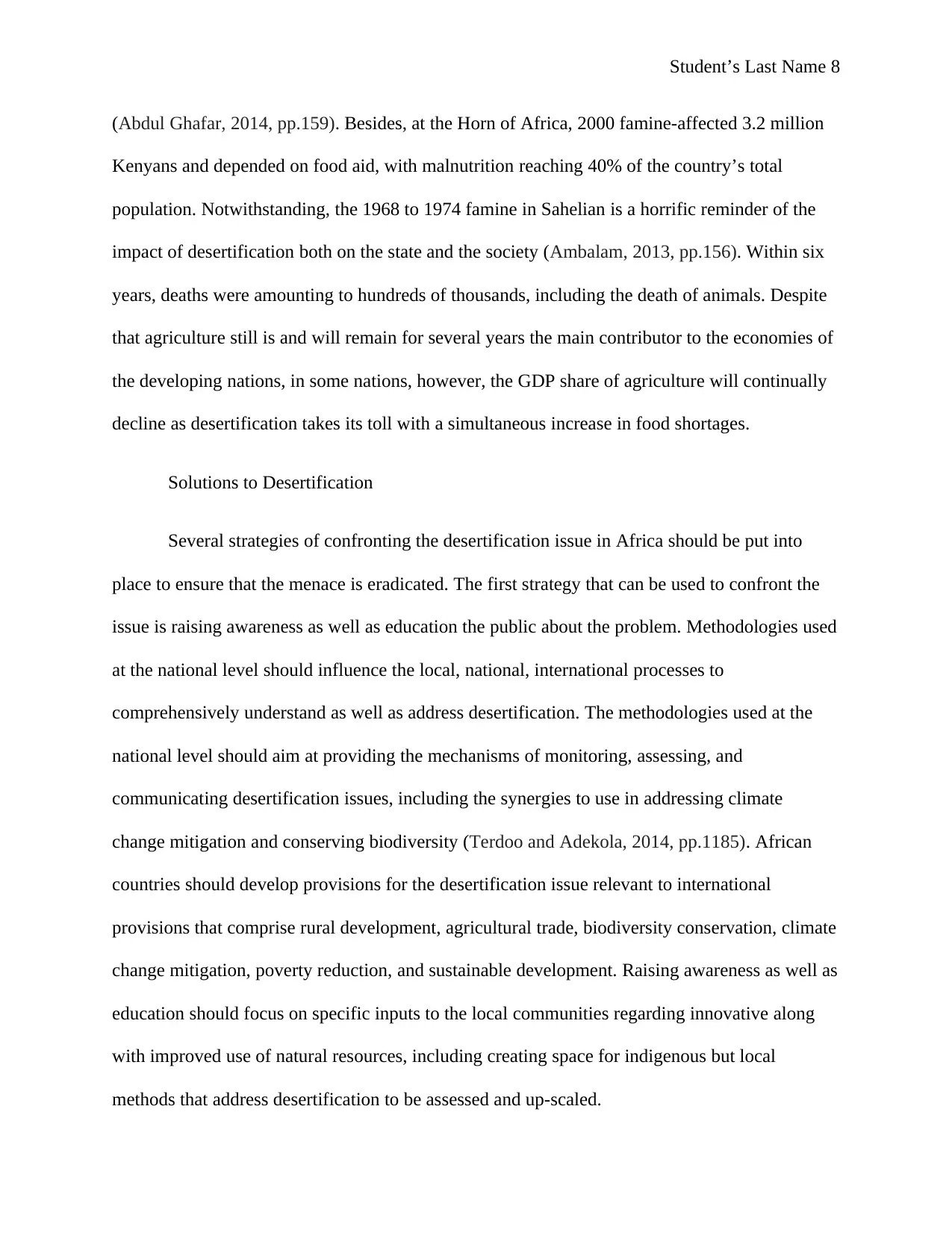
Student’s Last Name 8
(Abdul Ghafar, 2014, pp.159). Besides, at the Horn of Africa, 2000 famine-affected 3.2 million
Kenyans and depended on food aid, with malnutrition reaching 40% of the country’s total
population. Notwithstanding, the 1968 to 1974 famine in Sahelian is a horrific reminder of the
impact of desertification both on the state and the society (Ambalam, 2013, pp.156). Within six
years, deaths were amounting to hundreds of thousands, including the death of animals. Despite
that agriculture still is and will remain for several years the main contributor to the economies of
the developing nations, in some nations, however, the GDP share of agriculture will continually
decline as desertification takes its toll with a simultaneous increase in food shortages.
Solutions to Desertification
Several strategies of confronting the desertification issue in Africa should be put into
place to ensure that the menace is eradicated. The first strategy that can be used to confront the
issue is raising awareness as well as education the public about the problem. Methodologies used
at the national level should influence the local, national, international processes to
comprehensively understand as well as address desertification. The methodologies used at the
national level should aim at providing the mechanisms of monitoring, assessing, and
communicating desertification issues, including the synergies to use in addressing climate
change mitigation and conserving biodiversity (Terdoo and Adekola, 2014, pp.1185). African
countries should develop provisions for the desertification issue relevant to international
provisions that comprise rural development, agricultural trade, biodiversity conservation, climate
change mitigation, poverty reduction, and sustainable development. Raising awareness as well as
education should focus on specific inputs to the local communities regarding innovative along
with improved use of natural resources, including creating space for indigenous but local
methods that address desertification to be assessed and up-scaled.
(Abdul Ghafar, 2014, pp.159). Besides, at the Horn of Africa, 2000 famine-affected 3.2 million
Kenyans and depended on food aid, with malnutrition reaching 40% of the country’s total
population. Notwithstanding, the 1968 to 1974 famine in Sahelian is a horrific reminder of the
impact of desertification both on the state and the society (Ambalam, 2013, pp.156). Within six
years, deaths were amounting to hundreds of thousands, including the death of animals. Despite
that agriculture still is and will remain for several years the main contributor to the economies of
the developing nations, in some nations, however, the GDP share of agriculture will continually
decline as desertification takes its toll with a simultaneous increase in food shortages.
Solutions to Desertification
Several strategies of confronting the desertification issue in Africa should be put into
place to ensure that the menace is eradicated. The first strategy that can be used to confront the
issue is raising awareness as well as education the public about the problem. Methodologies used
at the national level should influence the local, national, international processes to
comprehensively understand as well as address desertification. The methodologies used at the
national level should aim at providing the mechanisms of monitoring, assessing, and
communicating desertification issues, including the synergies to use in addressing climate
change mitigation and conserving biodiversity (Terdoo and Adekola, 2014, pp.1185). African
countries should develop provisions for the desertification issue relevant to international
provisions that comprise rural development, agricultural trade, biodiversity conservation, climate
change mitigation, poverty reduction, and sustainable development. Raising awareness as well as
education should focus on specific inputs to the local communities regarding innovative along
with improved use of natural resources, including creating space for indigenous but local
methods that address desertification to be assessed and up-scaled.
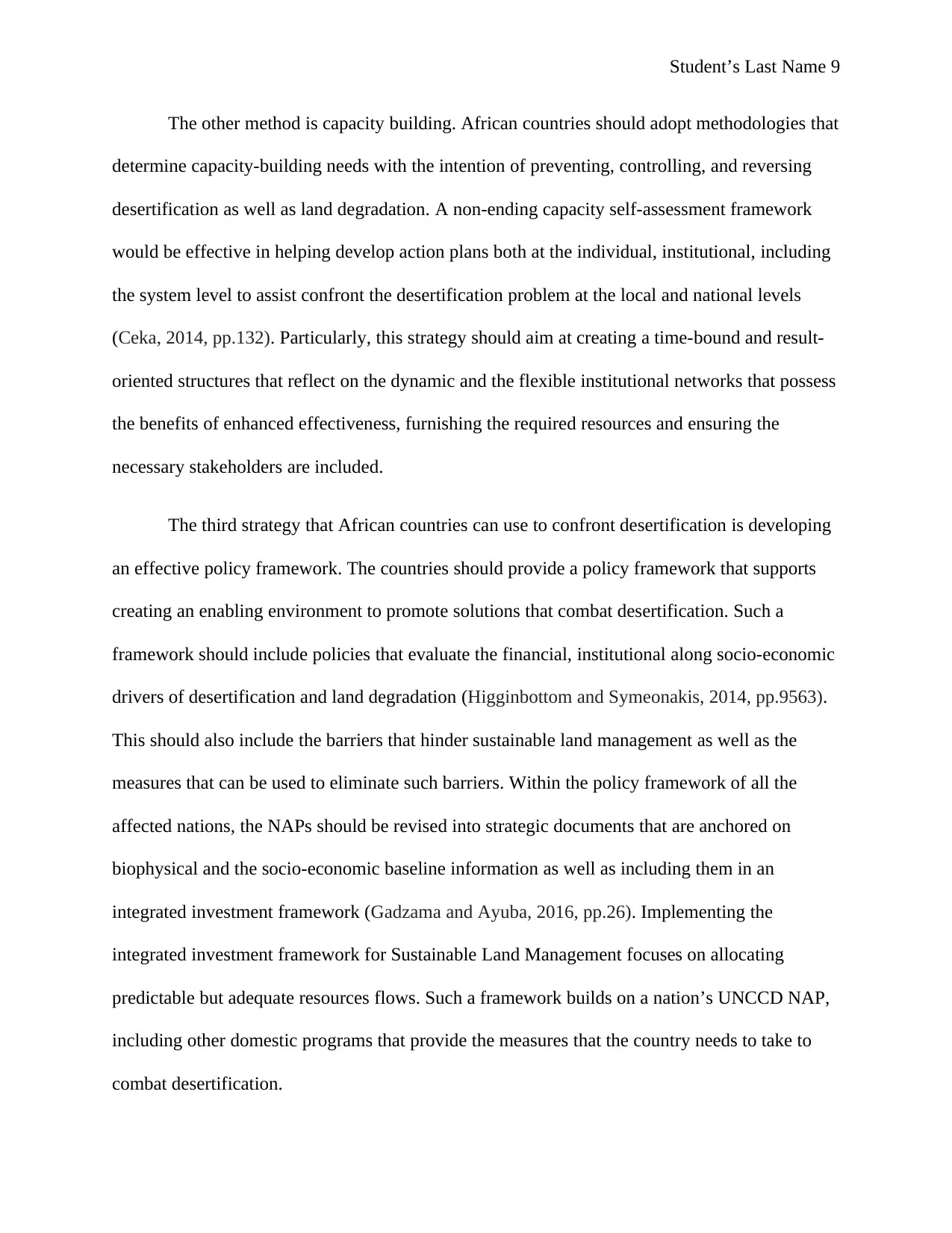
Student’s Last Name 9
The other method is capacity building. African countries should adopt methodologies that
determine capacity-building needs with the intention of preventing, controlling, and reversing
desertification as well as land degradation. A non-ending capacity self-assessment framework
would be effective in helping develop action plans both at the individual, institutional, including
the system level to assist confront the desertification problem at the local and national levels
(Ceka, 2014, pp.132). Particularly, this strategy should aim at creating a time-bound and result-
oriented structures that reflect on the dynamic and the flexible institutional networks that possess
the benefits of enhanced effectiveness, furnishing the required resources and ensuring the
necessary stakeholders are included.
The third strategy that African countries can use to confront desertification is developing
an effective policy framework. The countries should provide a policy framework that supports
creating an enabling environment to promote solutions that combat desertification. Such a
framework should include policies that evaluate the financial, institutional along socio-economic
drivers of desertification and land degradation (Higginbottom and Symeonakis, 2014, pp.9563).
This should also include the barriers that hinder sustainable land management as well as the
measures that can be used to eliminate such barriers. Within the policy framework of all the
affected nations, the NAPs should be revised into strategic documents that are anchored on
biophysical and the socio-economic baseline information as well as including them in an
integrated investment framework (Gadzama and Ayuba, 2016, pp.26). Implementing the
integrated investment framework for Sustainable Land Management focuses on allocating
predictable but adequate resources flows. Such a framework builds on a nation’s UNCCD NAP,
including other domestic programs that provide the measures that the country needs to take to
combat desertification.
The other method is capacity building. African countries should adopt methodologies that
determine capacity-building needs with the intention of preventing, controlling, and reversing
desertification as well as land degradation. A non-ending capacity self-assessment framework
would be effective in helping develop action plans both at the individual, institutional, including
the system level to assist confront the desertification problem at the local and national levels
(Ceka, 2014, pp.132). Particularly, this strategy should aim at creating a time-bound and result-
oriented structures that reflect on the dynamic and the flexible institutional networks that possess
the benefits of enhanced effectiveness, furnishing the required resources and ensuring the
necessary stakeholders are included.
The third strategy that African countries can use to confront desertification is developing
an effective policy framework. The countries should provide a policy framework that supports
creating an enabling environment to promote solutions that combat desertification. Such a
framework should include policies that evaluate the financial, institutional along socio-economic
drivers of desertification and land degradation (Higginbottom and Symeonakis, 2014, pp.9563).
This should also include the barriers that hinder sustainable land management as well as the
measures that can be used to eliminate such barriers. Within the policy framework of all the
affected nations, the NAPs should be revised into strategic documents that are anchored on
biophysical and the socio-economic baseline information as well as including them in an
integrated investment framework (Gadzama and Ayuba, 2016, pp.26). Implementing the
integrated investment framework for Sustainable Land Management focuses on allocating
predictable but adequate resources flows. Such a framework builds on a nation’s UNCCD NAP,
including other domestic programs that provide the measures that the country needs to take to
combat desertification.
⊘ This is a preview!⊘
Do you want full access?
Subscribe today to unlock all pages.

Trusted by 1+ million students worldwide
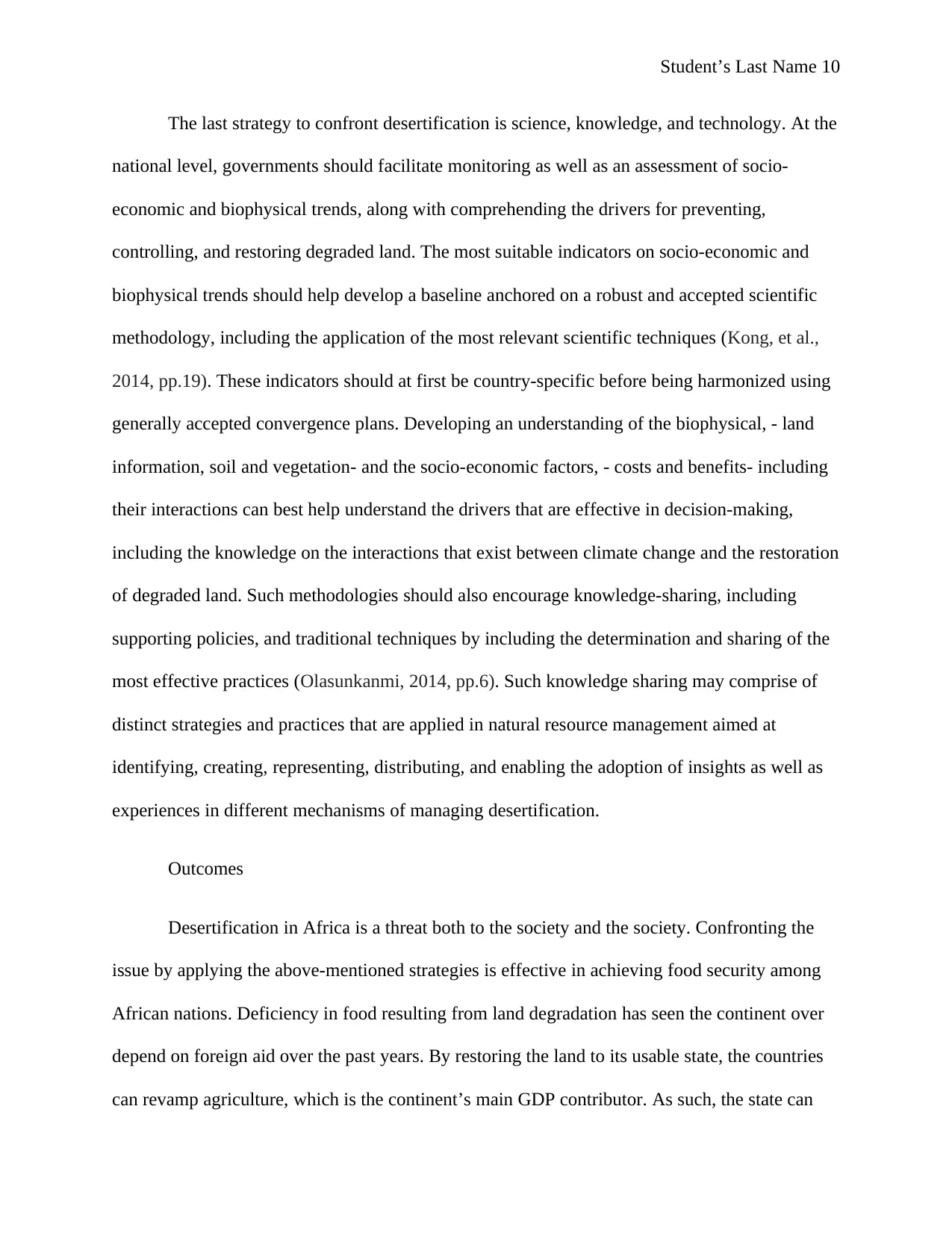
Student’s Last Name 10
The last strategy to confront desertification is science, knowledge, and technology. At the
national level, governments should facilitate monitoring as well as an assessment of socio-
economic and biophysical trends, along with comprehending the drivers for preventing,
controlling, and restoring degraded land. The most suitable indicators on socio-economic and
biophysical trends should help develop a baseline anchored on a robust and accepted scientific
methodology, including the application of the most relevant scientific techniques (Kong, et al.,
2014, pp.19). These indicators should at first be country-specific before being harmonized using
generally accepted convergence plans. Developing an understanding of the biophysical, - land
information, soil and vegetation- and the socio-economic factors, - costs and benefits- including
their interactions can best help understand the drivers that are effective in decision-making,
including the knowledge on the interactions that exist between climate change and the restoration
of degraded land. Such methodologies should also encourage knowledge-sharing, including
supporting policies, and traditional techniques by including the determination and sharing of the
most effective practices (Olasunkanmi, 2014, pp.6). Such knowledge sharing may comprise of
distinct strategies and practices that are applied in natural resource management aimed at
identifying, creating, representing, distributing, and enabling the adoption of insights as well as
experiences in different mechanisms of managing desertification.
Outcomes
Desertification in Africa is a threat both to the society and the society. Confronting the
issue by applying the above-mentioned strategies is effective in achieving food security among
African nations. Deficiency in food resulting from land degradation has seen the continent over
depend on foreign aid over the past years. By restoring the land to its usable state, the countries
can revamp agriculture, which is the continent’s main GDP contributor. As such, the state can
The last strategy to confront desertification is science, knowledge, and technology. At the
national level, governments should facilitate monitoring as well as an assessment of socio-
economic and biophysical trends, along with comprehending the drivers for preventing,
controlling, and restoring degraded land. The most suitable indicators on socio-economic and
biophysical trends should help develop a baseline anchored on a robust and accepted scientific
methodology, including the application of the most relevant scientific techniques (Kong, et al.,
2014, pp.19). These indicators should at first be country-specific before being harmonized using
generally accepted convergence plans. Developing an understanding of the biophysical, - land
information, soil and vegetation- and the socio-economic factors, - costs and benefits- including
their interactions can best help understand the drivers that are effective in decision-making,
including the knowledge on the interactions that exist between climate change and the restoration
of degraded land. Such methodologies should also encourage knowledge-sharing, including
supporting policies, and traditional techniques by including the determination and sharing of the
most effective practices (Olasunkanmi, 2014, pp.6). Such knowledge sharing may comprise of
distinct strategies and practices that are applied in natural resource management aimed at
identifying, creating, representing, distributing, and enabling the adoption of insights as well as
experiences in different mechanisms of managing desertification.
Outcomes
Desertification in Africa is a threat both to the society and the society. Confronting the
issue by applying the above-mentioned strategies is effective in achieving food security among
African nations. Deficiency in food resulting from land degradation has seen the continent over
depend on foreign aid over the past years. By restoring the land to its usable state, the countries
can revamp agriculture, which is the continent’s main GDP contributor. As such, the state can
Paraphrase This Document
Need a fresh take? Get an instant paraphrase of this document with our AI Paraphraser

Student’s Last Name 11
achieve food security and be able to feed the growing population. Nonetheless, desertification is
the main contributor to diseases in African states. The continent has seen many deaths resulting
from diseases that arise due to lack of adequate and clean water and food, specifically in the
drylands. Malnutrition has been the greatest contributor to these deaths (Stringer and Dougill,
2013, pp.331). Putting in place measures to confront and combat desertification such as those
suggested above can help the affected countries provide clean water and food to all its citizens
and as a result, combat the death rates resulting from disease. Poverty is closely interlinked with
desertification particularly in African states where people depend on agriculture for living and as
a source of income. High population rates are leading land encroachments as people seek more
land to cultivate and settle.
Creating awareness and educating the general public on the importance of confronting
desertification can be the best solution that African states can adopt to eliminate desertification
and restore land biodiversity. Creating awareness can help address the issue by informing the
public on the best methods of farming that do not degrade the land. Nonetheless, encouraging the
adoption of alternative methods of energy rather than biomass can effectively solve the issue.
Desertification has resulted to slow economic growth in African states due to their
overdependence on agriculture, and this has contributed to high poverty rates (Burmamu,
Timtere and Aliyu, 2013, pp.1158). Adopting resolutions to combat desertification can be the
first taken to curb poverty in Africa because it would restore the continent’s agricultural
performance, thus boosting the growth of the economy. Combating desertification through
various methods such as putting in place a policy framework to support the implementation of an
effective action plan can help restore biodiversity, thus achieving environmental sustainability.
achieve food security and be able to feed the growing population. Nonetheless, desertification is
the main contributor to diseases in African states. The continent has seen many deaths resulting
from diseases that arise due to lack of adequate and clean water and food, specifically in the
drylands. Malnutrition has been the greatest contributor to these deaths (Stringer and Dougill,
2013, pp.331). Putting in place measures to confront and combat desertification such as those
suggested above can help the affected countries provide clean water and food to all its citizens
and as a result, combat the death rates resulting from disease. Poverty is closely interlinked with
desertification particularly in African states where people depend on agriculture for living and as
a source of income. High population rates are leading land encroachments as people seek more
land to cultivate and settle.
Creating awareness and educating the general public on the importance of confronting
desertification can be the best solution that African states can adopt to eliminate desertification
and restore land biodiversity. Creating awareness can help address the issue by informing the
public on the best methods of farming that do not degrade the land. Nonetheless, encouraging the
adoption of alternative methods of energy rather than biomass can effectively solve the issue.
Desertification has resulted to slow economic growth in African states due to their
overdependence on agriculture, and this has contributed to high poverty rates (Burmamu,
Timtere and Aliyu, 2013, pp.1158). Adopting resolutions to combat desertification can be the
first taken to curb poverty in Africa because it would restore the continent’s agricultural
performance, thus boosting the growth of the economy. Combating desertification through
various methods such as putting in place a policy framework to support the implementation of an
effective action plan can help restore biodiversity, thus achieving environmental sustainability.
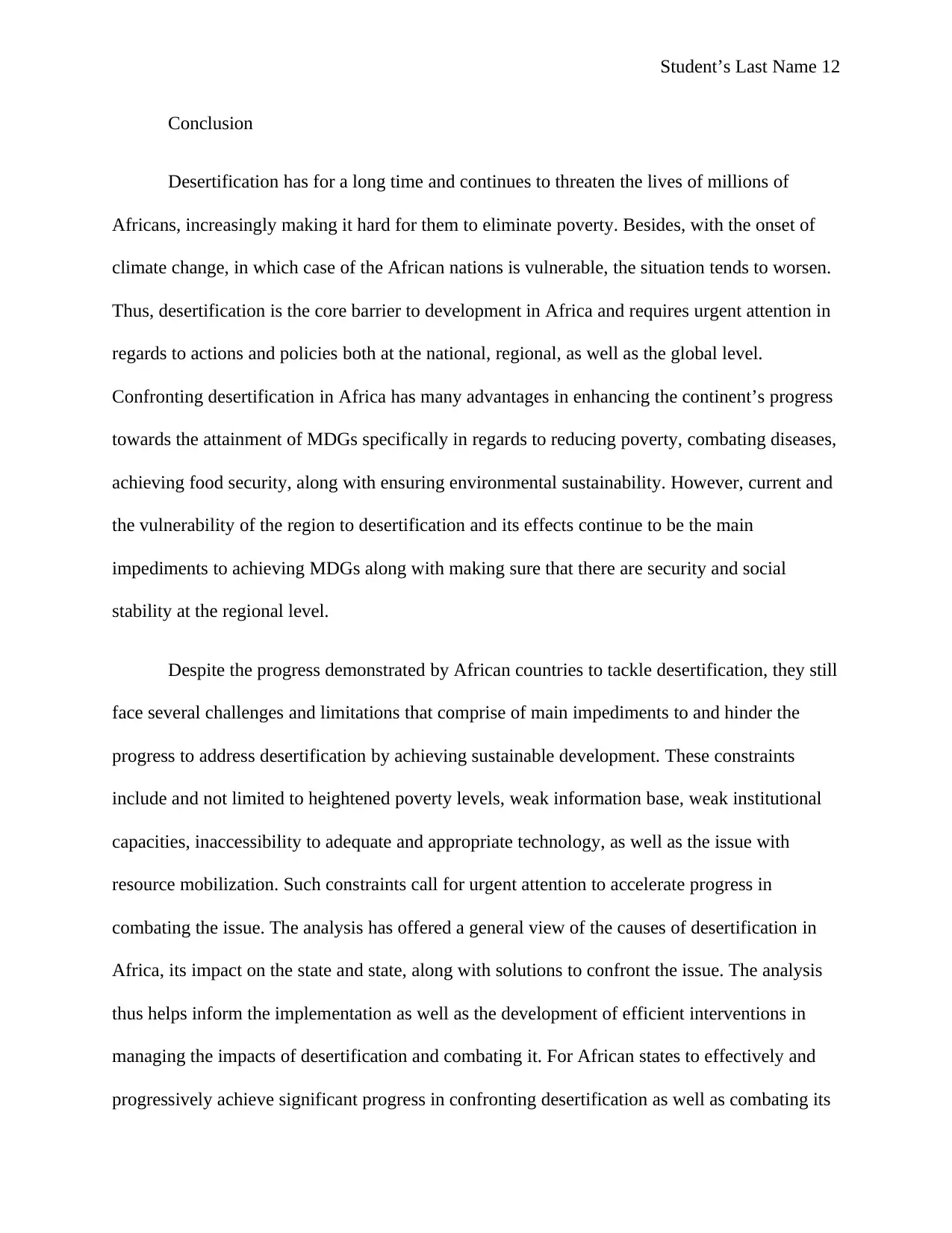
Student’s Last Name 12
Conclusion
Desertification has for a long time and continues to threaten the lives of millions of
Africans, increasingly making it hard for them to eliminate poverty. Besides, with the onset of
climate change, in which case of the African nations is vulnerable, the situation tends to worsen.
Thus, desertification is the core barrier to development in Africa and requires urgent attention in
regards to actions and policies both at the national, regional, as well as the global level.
Confronting desertification in Africa has many advantages in enhancing the continent’s progress
towards the attainment of MDGs specifically in regards to reducing poverty, combating diseases,
achieving food security, along with ensuring environmental sustainability. However, current and
the vulnerability of the region to desertification and its effects continue to be the main
impediments to achieving MDGs along with making sure that there are security and social
stability at the regional level.
Despite the progress demonstrated by African countries to tackle desertification, they still
face several challenges and limitations that comprise of main impediments to and hinder the
progress to address desertification by achieving sustainable development. These constraints
include and not limited to heightened poverty levels, weak information base, weak institutional
capacities, inaccessibility to adequate and appropriate technology, as well as the issue with
resource mobilization. Such constraints call for urgent attention to accelerate progress in
combating the issue. The analysis has offered a general view of the causes of desertification in
Africa, its impact on the state and state, along with solutions to confront the issue. The analysis
thus helps inform the implementation as well as the development of efficient interventions in
managing the impacts of desertification and combating it. For African states to effectively and
progressively achieve significant progress in confronting desertification as well as combating its
Conclusion
Desertification has for a long time and continues to threaten the lives of millions of
Africans, increasingly making it hard for them to eliminate poverty. Besides, with the onset of
climate change, in which case of the African nations is vulnerable, the situation tends to worsen.
Thus, desertification is the core barrier to development in Africa and requires urgent attention in
regards to actions and policies both at the national, regional, as well as the global level.
Confronting desertification in Africa has many advantages in enhancing the continent’s progress
towards the attainment of MDGs specifically in regards to reducing poverty, combating diseases,
achieving food security, along with ensuring environmental sustainability. However, current and
the vulnerability of the region to desertification and its effects continue to be the main
impediments to achieving MDGs along with making sure that there are security and social
stability at the regional level.
Despite the progress demonstrated by African countries to tackle desertification, they still
face several challenges and limitations that comprise of main impediments to and hinder the
progress to address desertification by achieving sustainable development. These constraints
include and not limited to heightened poverty levels, weak information base, weak institutional
capacities, inaccessibility to adequate and appropriate technology, as well as the issue with
resource mobilization. Such constraints call for urgent attention to accelerate progress in
combating the issue. The analysis has offered a general view of the causes of desertification in
Africa, its impact on the state and state, along with solutions to confront the issue. The analysis
thus helps inform the implementation as well as the development of efficient interventions in
managing the impacts of desertification and combating it. For African states to effectively and
progressively achieve significant progress in confronting desertification as well as combating its
⊘ This is a preview!⊘
Do you want full access?
Subscribe today to unlock all pages.

Trusted by 1+ million students worldwide
1 out of 16
Related Documents
Your All-in-One AI-Powered Toolkit for Academic Success.
+13062052269
info@desklib.com
Available 24*7 on WhatsApp / Email
![[object Object]](/_next/static/media/star-bottom.7253800d.svg)
Unlock your academic potential
Copyright © 2020–2025 A2Z Services. All Rights Reserved. Developed and managed by ZUCOL.



